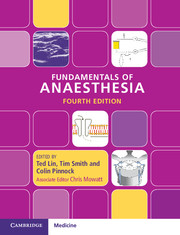Book contents
- Fundamentals of Anaesthesia
- Fundamentals of Anaesthesia
- Copyright page
- Dedication
- Contents
- Contributors
- Preface to the first edition
- Preface to the second edition
- Preface to the third edition
- Preface to the fourth edition
- Acknowledgements
- Abbreviations
- Section 1 Clinical anaesthesia
- Chapter 1 Preoperative management
- Chapter 2 Conduct of anaesthesia
- Chapter 3 Intraoperative management
- Chapter 4 Postoperative management
- Chapter 5 Special patient circumstances
- Chapter 6 The surgical insult
- Chapter 7 Regional anaesthesia
- Chapter 8 Principles of resuscitation
- Chapter 9 Major trauma
- Section 2 Physiology
- Section 3 Pharmacology
- Section 4 Physics and clinical measurement
- Index
- References
Chapter 5 - Special patient circumstances
from Section 1 - Clinical anaesthesia
Published online by Cambridge University Press: 19 January 2017
- Fundamentals of Anaesthesia
- Fundamentals of Anaesthesia
- Copyright page
- Dedication
- Contents
- Contributors
- Preface to the first edition
- Preface to the second edition
- Preface to the third edition
- Preface to the fourth edition
- Acknowledgements
- Abbreviations
- Section 1 Clinical anaesthesia
- Chapter 1 Preoperative management
- Chapter 2 Conduct of anaesthesia
- Chapter 3 Intraoperative management
- Chapter 4 Postoperative management
- Chapter 5 Special patient circumstances
- Chapter 6 The surgical insult
- Chapter 7 Regional anaesthesia
- Chapter 8 Principles of resuscitation
- Chapter 9 Major trauma
- Section 2 Physiology
- Section 3 Pharmacology
- Section 4 Physics and clinical measurement
- Index
- References
Summary
Obstetric anaesthesia requires detailed knowledge of the physiological changes associated with pregnancy. While these are covered thoroughly in Chapter 23, the salient points are outlined below to aid the reader.
- Type
- Chapter
- Information
- Fundamentals of Anaesthesia , pp. 79 - 127Publisher: Cambridge University PressPrint publication year: 2016

